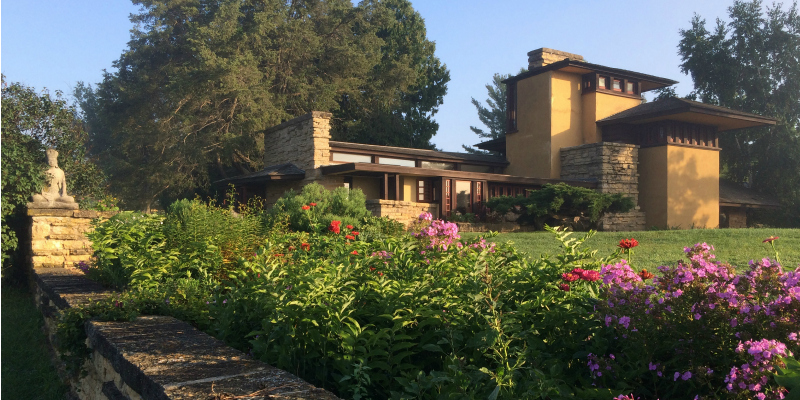PRESERVING FRANK LLOYD WRIGHT’S SEMINAL DESIGNS
By Marni McEntee | Photos courtesy Taliesin Preservation
Blink and you might miss the low-slung angles of Taliesin, the estate of legendary architect Frank Lloyd Wright, regardless of which way you approach its rural hillside perch outside Spring Green.
That’s by design, of course. In 1932 Wright said, “No building should ever be on the hill or on anything. It should be of the hill. Belonging to it. Hill and house should live together, each the happier for the other.”
Wright’s groundbreaking principles of organic and sustainable design endure today on the estate and around the country. Find his work in the modernist Guggenheim Museum in New York City, prairie-style personal homes that dot the Midwest and beyond, and offices, like the S.C. Johnson complex in Racine, Wisconsin.
This year, the 150th anniversary of Wright’s birth and the 50th anniversary of his eponymous visitor center at Taliesin, an on-site team of preservationists continues to keep to the architect’s dictums. They work daily to ensure that the estate’s buildings don’t return to the land from which they sprouted.
That means that even visitors who’ve been to the estate multiple times will almost certainly find something newly opened to the public or something that’s been recently, lovingly restored on their next visit. Taliesin is constantly being reborn.
It always has been.
“Think of this house as more or less of a sketch,” Taliesin Collection and Preservation Project Manager Ryan Hewson says of the manor house. Wright often designed by trial and error, using inexpensive and sometimes short-lived materials to turn the home into a scale model for his design concepts, structural assemblies and materials.
Taliesin Preservation, Inc., launched in 1990, has a goal of preserving the historic core of the estate to the years 1950 to 1959. “We try to leave as much of the original behind as we can,” Hewson says.
Over the years, the preservation team has done much to make parts of the 800-acre estate, homesteaded by Wright’s Welsh grandparents, and its 20 buildings suitable also for fundraising purposes. Much of the proceeds are funneled back to preservation work.
This month, a multi-year restoration of Tan-y-Deri, a shingled prairie home Wright built for his sister in 1907, will be complete. In 2015, preservation of the loggia area of Wright’s home was completed and opened to the public for the first time in 20 years. Just inside its doors were a series of delicate Chinese silk screens that were sent to experts for restoration.
The constant upgrades often are invisible to visitors. Recently, the crew shored up the crumbling portion of the main home’s foundation and prepared the building for a geothermal heating and cooling system. Its lower level guest wing, originally housing for Wright’s apprentices, also was upgraded with new bathrooms and a kitchen facility. The wing will be used for corporate retreats, overnight stays and guest lecturers and visiting faculty.
The result, says communication coordinator Aron Meudt-Thering, is that Taliesin can continue to welcome the public and special guests, just as Wright did in his day, entertaining luminaries like architect Buckminster Fuller and writers Ayn Rand and Carl Sandburg. Lady Bird Johnson attended the 1967 grand opening of the Riverview Terrace, now the Frank Lloyd Wright Visitor Center.
They’ll come for the architecture or the history, the drama or the landscape, Meudt-Thering says. “There isn’t one ‘Taliesin story,’” Meudt-Thering says. “Everybody gets what they want out of it.” To be sure, work’s underway to ensure that Taliesin—which means shining brow in Welsh—will be winking at us from its prairie home for generations to come.
Follow the Frank Lloyd Wright Trail
The Wisconsin Department of Tourism has created a self-guided tour through Southern Wisconsin that includes nine of Frank Lloyd Wright’s famous buildings. The sites include:
- S. C. Johnson Administration Building, Racine
- S. C. Johnson Research Tower, Racine
- Wingspread historic home, Wind Point
- Burnham Street American System-Built homes, Milwaukee
- Monona Terrace, Madison
- First Unitarian Society Meeting House, Madison
- Taliesin and the Frank Lloyd Wright Visitor Center, Spring Green
- Wyoming Valley School Cultural Arts Center, Spring Green
- AD German Warehouse, Richland Center
Visit travelwisconsin.com for more information.
This article is one of three articles in our “Home & Garden” feature from the June 2017 issue. Click to read Peace & Quiet and Rural Splendor.





Comments are closed.